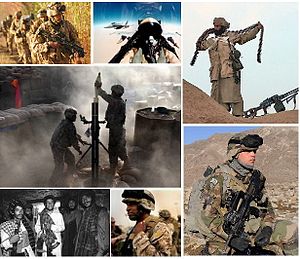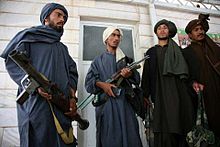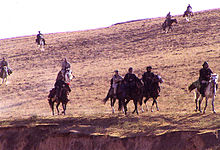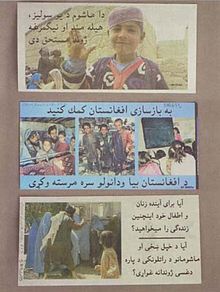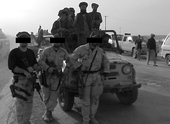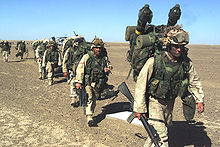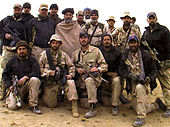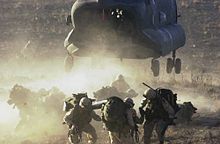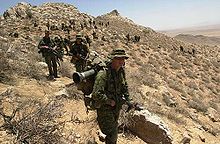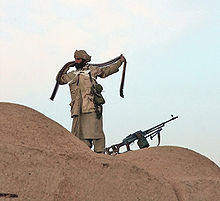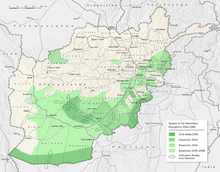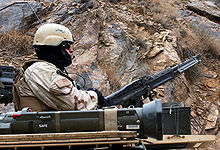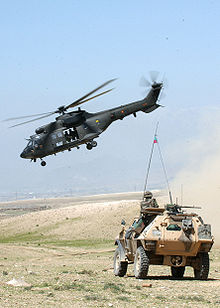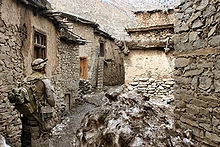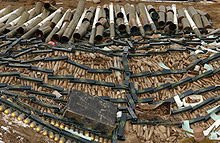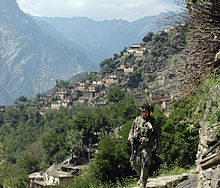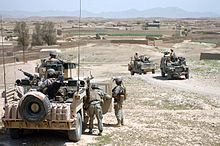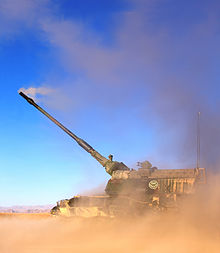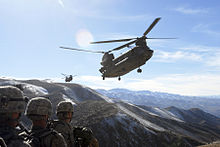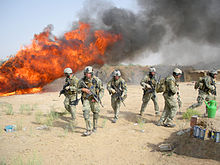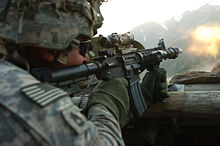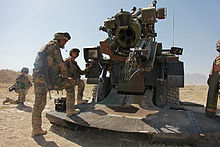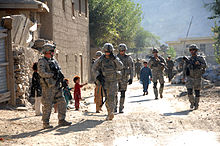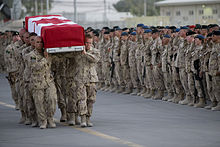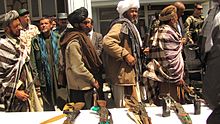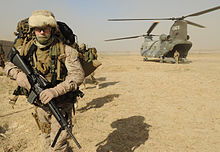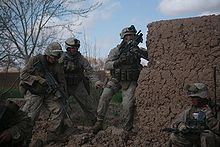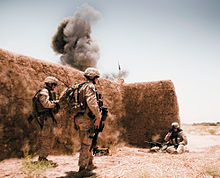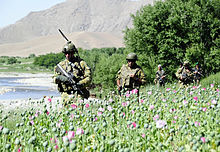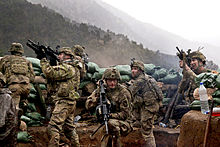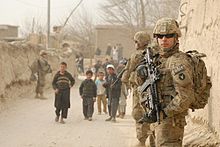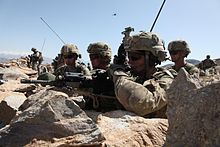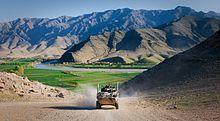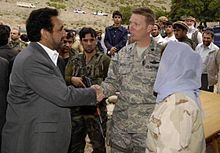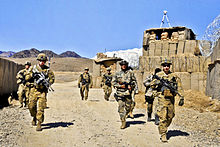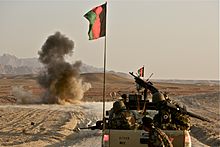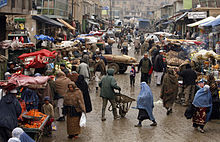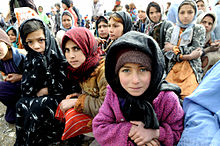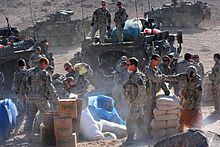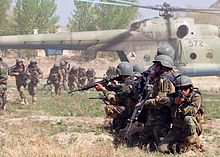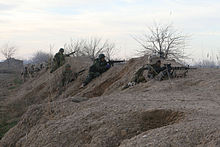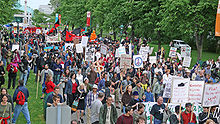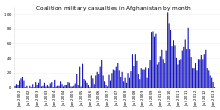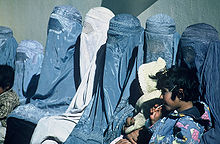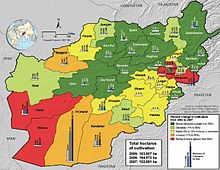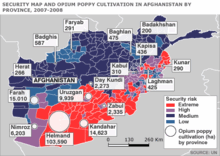
War in Afghanistan (2001–present)
Background Information
SOS Children produced this website for schools as well as this video website about Africa. Visit the SOS Children website at http://www.soschildren.org/
|
||||||||||||||||||||||||||||||||||||||||||||||||
|
||||||||||||||||||||||||||||||||||||||||||||||||
The War in Afghanistan began on 7 October 2001, when the armed forces of the United States, the United Kingdom, Australia, France, and the Afghan United Front (Northern Alliance) launched Operation Enduring Freedom. The U.S. organized the operation in response to the terrorist attacks of September 11 in the United States. The objective of the invasion was to dismantle the Al Qaeda organization and end its use of Afghanistan as a base. The U.S. also intended to remove the fundamentalist Taliban regime from power in Afghanistan. The Taliban protected Al Qaeda and had refused to arrest Osama bin Laden for his ordering of the September 11 terrorist attacks.
The U.S. and its allies were initially successful in removing the Taliban from power in Kabul and the other major towns and cities of Afghanistan; however, many members of the Al Qaeda and Taliban organizations safely escaped the country. The International Security Assistance Force (ISAF) was established by the U.N. Security Council at the end of December 2001, and NATO assumed control of ISAF in 2003. ISAF included troops from 42 countries, with NATO members providing the core of the force. An attempt was made to establish a new Afghan government with the help of the U.S. and its allies; and the Islamic Republic of Afghanistan was established under the interim government of Hamid Karzai, who was elected President in 2004.
In 2003, Taliban forces started an insurgency campaign against the Afghan government and ISAF-troops. Starting in 2006, there was a dramatic increase in Taliban-led insurgent activity in Afghanistan; NATO increased the number of its soldiers assigned to the country.
In 2011, while NATO forces continued to battle the Taliban insurgency, the war expanded into the tribal areas of neighboring North-WestPakistan. On 2 May 2011, U.S. forces killed Osama bin Laden in Abbotabad, Pakistan. On 21 May 2012 the leaders of the NATO-member countries endorsed an exit strategy for removing NATO soldiers from Afghanistan.
Since the coalition intervention in 2001, more than 5.7 million refugees have returned to Afghanistan but 2.2 million Afghans remained refugees in 2013 and in January, 2013 the UN estimated that there were 547,550 internally displaced persons within Afghanistan, a 25% increase over the 447,547 IDPs in January, 2012 a figure reflected by Amnesty International when it reported that hundreds of Afghans were forced to flee their homes everyday during 2012.
As of 2013, there are 8.2 million Afghan students in school, including 3.2 million girls. This is up from the 1.2 million students that were attending school in 2001, with less than 50,000 of them girls.
Tens of thousands of soldiers and civilians have lost their lives in the war.
History of the conflict
Historical background (1996–2001)
Taliban Emirate vs United Front
Afghans wore down the Russian forces in the Afghan-Soviet War, which withdrew from Afghanistan. Warfare broke out among the various warlords and militia units competing for control.
In late 1994, most of the militia factions fighting for control of Kabul were militarily defeated by forces of the Islamic State's Secretary of Defense Ahmad Shah Massoud. Bombardment of the capital came to a halt. Massoud tried to initiate a nationwide political process with the goal of national consolidation and democratic elections, inviting the Taliban to join the process. The Taliban declined.
The Taliban's early victories in 1994 were followed by a series of defeats that resulted in heavy losses. Pakistan provided strong support to the Taliban. Many analysts, such as Amin Saikal, described the Taliban as developing into a proxy force for Pakistan's regional interests, which the Taliban deny.
The Taliban started shelling Kabul in early 1995 but were defeated by forces of the Islamic State government under Ahmad Shah Massoud. ( see video) Amnesty International, referring to the Taliban offensive, wrote in a 1995 report:
This is the first time in several months that Kabul civilians have become the targets of rocket attacks and shelling aimed at residential areas in the city.—Amnesty International, 1995
On 26 September 1996, as the Taliban, with military support by Pakistan and financial support by Saudi Arabia, prepared for another major offensive, Massoud ordered a full retreat from Kabul. The Taliban seized Kabul on 27 September 1996, and established the Islamic Emirate of Afghanistan. They imposed their fundamentalist interpretation of Islam in areas under their control, issuing edicts forbidding women to work outside the home, attend school, or to leave their homes unless accompanied by a male relative.
Ahmad Shah Massoud and Abdul Rashid Dostum, two former arch-enemies, created the United Front ( Northern Alliance) against the Taliban. They prepared offensives in the remaining areas under the control of Massoud and Dostum. ( see video) In addition to the Tajik forces of Massoud and the Uzbek forces of Dostum, the United Front included Hazara factions and Pashtun forces under the leadership of commanders such as Abdul Haq and Haji Abdul Qadir.
After the Taliban defeated Dostum's Junbish forces by seizing Mazar-i-Sharif in 1998, Dostum went into exile.
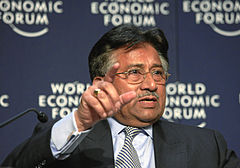
According to a 55-page report by the United Nations (UN), the Taliban, while trying to consolidate control over northern and western Afghanistan, committed systematic massacres against civilians. They said these were similar to massacres of civilians in Bosnia. U.N. officials stated that there had been "15 massacres" between 1996 and 2001. They also said, that "[t]hese have been highly systematic and they all lead back to the [Taliban] Ministry of Defense or to Mullah Omar himself." The Taliban especially targeted people of Shia religious or Hazara ethnic background.
As the Taliban took Mazar-i-Sharif in 1998, they executed about 4,000 civilians and many more reported tortured. The documents also reveal the role of Arab and Pakistani support troops in these killings. Bin Laden's so-called 055 Brigade was responsible for mass-killings of Afghan civilians. The report by the United Nations quotes eyewitnesses in many villages describing "Arab fighters carrying long knives used for slitting throats and skinning people".
According to the Pakistani expert Ahmed Rashid, "between 1994 and 1999, an estimated 80,000 to 100,000 Pakistanis trained and fought in Afghanistan" on the side of the Taliban. Peter Tomsen said that up until 9/11, Pakistani military and ISI officers, along with thousands of regular Pakistani armed forces personnel, had been involved in the fighting in Afghanistan.
In 2001 alone, according to several international sources, 28,000-30,000 Pakistani nationals, 14,000-15,000 Afghan Taliban, and 2,000-3,000 Al Qaeda militants were fighting against anti-Taliban forces in Afghanistan as a roughly 45,000-strong military force. Pakistani Pervez Musharraf, then Chief of Army Staff, was responsible for sending thousands of Pakistanis to fight alongside the Taliban and Bin Laden against the forces of Ahmad Shah Massoud. Of the estimated 28,000 Pakistani nationals fighting in Afghanistan, 8,000 were militants recruited in madrassas, who filled regular Taliban ranks.
A 1998 document by the U.S. State Department confirmed that "20–40 percent of [regular] Taliban soldiers are Pakistani." The document said that many of the parents of those Pakistani nationals "know nothing regarding their child's military involvement with the Taliban until their bodies are brought back to Pakistan." According to the U.S. State Department report and reports by Human Rights Watch, the other Pakistani nationals fighting in Afghanistan were regular soldiers, especially from the Frontier Corps, but also from the army providing direct combat support.
The 9/11 Commission in the US reported found that under the Taliban, al-Qaeda was able to use Afghanistan as a place to train and indoctrinate fighters, import weapons, coordinate with other jihadists, and plot terrorist actions. While al-Qaeda maintained its own camps in Afghanistan, it also supported training camps of other organizations. An estimated 10,000 and 20,000 men passed through these facilities before 9/11, most of whom were sent to fight for the Taliban against the United Front. A smaller number were inducted into al-Qaeda.
After the August 1998 U.S. Embassy bombings were linked to bin Laden, President Bill Clinton ordered missile strikes on militant training camps in Afghanistan. U.S. officials pressed the Taliban to surrender bin Laden. In 1999, the international community imposed sanctions on the Taliban, calling for bin Laden to be surrendered. The Taliban repeatedly rebuffed their demands.
Central Intelligence Agency (CIA) Special Activities Division paramilitary teams were active in Afghanistan in the 1990s in clandestine operations to locate and kill or capture Osama bin Laden. These teams planned several operations but did not receive the order to execute from President Clinton. Their efforts built many of the relationships with Afghan leaders that proved essential in the 2001 U.S. invasion of Afghanistan.
Ahmad Shah Massoud was the only leader of the United Front in Afghanistan. In the areas under his control, Massoud set up democratic institutions and signed the Women's Rights Declaration. Human Rights Watch cites no human rights crimes for the forces under direct control of Massoud for the period from October 1996 until September 2001, when he was assassinated. As a consequence, many civilians had fled during those years to areas under his control. In total, estimates range up to one million people fleeing the Taliban. National Geographic concluded in its documentary, Inside the Taliban:
The only thing standing in the way of future Taliban massacres is Ahmad Shah Massoud.— National Geographic, "Inside the Taliban"
From 1999 on, Massoud, a Tajik, and Abdul Haq, a noted Pashtun commander, worked to unite the ethnic groups of Afghanistan to oppose the Taliban. While Massoud united the Tajiks, Hazara and Uzbeks as well as some Pashtun commanders under his United Front command, the Abdul Haq received increasing numbers of defecting Pashtun Taliban as "Taliban popularity trended downward". Both agreed to work together with the exiled Afghan king Zahir Shah. International officials who met with representatives of the new alliance, which the journalist Steve Coll referred to as the "grand Pashtun-Tajik alliance", said, "It's crazy that you have this today ... Pashtuns, Tajiks, Uzbeks, Hazara ... They were all ready to buy in to the process ... to work under the king's banner for an ethnically balanced Afghanistan." Senior diplomat and Afghanistan expert Peter Tomsen wrote: "The ‘Lion of Kabul’ [Abdul Haq] and the ‘Lion of Panjshir’ [Ahmad Shah Massoud] ... Haq, Massoud, and Karzai, Afghanistan’s three leading moderates, could transcend the Pashtun—non-Pashtun, north-south divide." The most senior Hazara and Uzbek leaders were also part of the process.
In late 2000, Massoud officially brought together this new alliance in a meeting in Northern Afghanistan to discuss "a Loya Jirga, or a traditional council of elders, to settle political turmoil in Afghanistan". That part of the Pashtun-Tajik-Hazara-Uzbek peace plan did eventually develop.
The journalist Sebastian Junger wrote about the meeting:
"In 2000, when I was there ... I happened to be there in a very interesting time. ... Massoud brought together Afghan leaders from all ethnic groups. They flew from London, Paris, the USA, all parts of Afghanistan, Pakistan, India. He brought them all into the northern area where he was. He held a council of ... prominent Afghans from all over the world, brought there to discuss the Afghan government after the Taliban. ... we met all these men and interviewed them briefly. One was Hamid Karzai; I did not have any idea who he would end up being ..."
In early 2001, Massoud, with other ethnic leaders, addressed the European Parliament in Brussels, asking the international community to provide humanitarian help to the people of Afghanistan.( see video) He said that the Taliban and al-Qaeda had introduced "a very wrong perception of Islam" and that without the support of Pakistan and Osama bin Laden, the Taliban would not be able to sustain their military campaign for up to a year. On this visit to Europe, he warned that his intelligence had gathered information about a large-scale attack on U.S. soil being imminent.
Change in U.S. policy toward Afghanistan
During the Clinton administration, the U.S. tended to favour Pakistan and until 1998-1999 had no clear policy toward Afghanistan. In 1997, for instance, the U.S. State Department's Robin Raphel told Ahmad Shah Massoud to surrender to the Taliban. Massoud responded that, as long as he controlled an area the size of his hat, he would continue to defend it from the Taliban. Around the same time, top foreign policy officials in the Clinton administration flew to northern Afghanistan to try to persuade the United Front not to take advantage of a chance to make crucial gains against the Taliban. They insisted it was the time for a cease-fire and an arms embargo. At the time, Pakistan began a "Berlin-like airlift to resupply and re-equip the Taliban", financed with Saudi money.
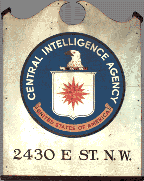
U.S. policy toward Afghanistan changed after the 1998 U.S. embassy bombings. Subsequently, Osama bin Laden was indicted for his involvement in the embassy bombings. In 1999 both the U.S. and the United Nations enacted sanctions against the Taliban via United Nations Security Council Resolution 1267, which demanded the Taliban surrender Osama bin Laden for trial in the U.S. and close all terrorist bases in Afghanistan. The only collaboration between Massoud and the US at the time was an effort with the CIA to trace Osama bin Laden following the 1998 bombings. The U.S. and the European Union provided no support to Massoud for the fight against the Taliban.
By 2001 the change of policy sought by CIA officers who knew Massoud was underway. According to Steve Coll in his book Ghost Wars (2004) (which won the 2005 Pulitzer Prize for General Non-Fiction):
The CIA officers admired Massoud greatly. They saw him as a Che Guevara figure, a great actor on history’s stage. Massoud was a poet, a military genius, a religious man, and a leader of enormous courage who defied death and accepted its inevitability, they thought.... In his house there were thousands of books: Persian poetry, histories of the Afghan war in multiple languages, biographies of other military and guerrilla leaders. In their meetings Massoud wove sophisticated, measured references to Afghan history and global politics into his arguments. He was quiet, forceful, reserved, and full of dignity, but also light in spirit. The CIA team had gone into the Panshjir as unabashed admirers of Massoud. Now their convictions deepened.— Steve Coll in Ghost Wars, 2004
CIA lawyers, working with officers in the Near East Division and Counter-terrorist Centre, began to draft a formal finding for President George W. Bush’s signature, authorizing a new covert action program in Afghanistan. It would be the first in a decade to seek to influence the course of the Afghan war in favour of Massoud. Richard A. Clarke, chair of the Counter-Terrorism Security Group under the Clinton administration, and later an official in the Bush administration, allegedly presented a plan to incoming Bush administration official Condoleezza Rice in January 2001.
According to later reporting, a change in US policy was concluded in August 2001. The Bush administration agreed on a plan to start giving support to the anti-Taliban forces of Ahmad Shah Massoud, who sought to create a democratic form of government in Afghanistan. A meeting of the Bush administration's top national security officials agreed that the Taliban would be presented in negotiations with a final ultimatum to hand over Osama bin Laden and other leading al-Qaeda operatives. If the Taliban refused, the US would provide covert military aid to anti-Taliban groups. If both those options failed, "the deputies agreed that the United States would seek to overthrow the Taliban regime through more direct action."
9/11 September 2001
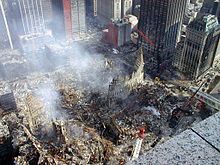
On 9 September 2001, Massoud, then aged 48, was critically wounded in a suicide attack by two Arabs posing as journalists, who detonated a bomb hidden in their video camera during an interview in Khoja Bahauddin, in the Takhar Province of Afghanistan. Massoud died in the helicopter taking him to a hospital. The funeral, held in a rural area, was attended by hundreds of thousands of mourning Afghans. International experts and members of the United Front, such as Amrullah Saleh, feared that without Massoud, the anti-Taliban resistance would not succeed.
On the morning of 11 September 2001, al-Qaeda carried out four coordinated attacks on U.S. soil. Four commercial passenger jet airliners were hijacked. The hijackers intentionally crashed two of the airliners into the Twin Towers of the World Trade Centre in New York City, killing everyone on board and thousands working in the buildings. Both buildings collapsed within two hours from fire damage related to the crashes, destroying nearby buildings and damaging others. The hijackers crashed a third airliner into the Pentagon in Arlington, Virginia, just outside Washington, D.C.. The fourth plane crashed into a field near Shanksville, in rural Pennsylvania, after some of its passengers and flight crew attempted to retake control of the plane, which the hijackers had redirected toward Washington, D.C to target the White House, or the U.S. Capitol. No flights had survivors.
Nearly 3,000 people, including the 19 hijackers, died in the attacks. According to the New York State Health Department, 836 responders, including firefighters and police personnel, have died as of June 2009.
Legal basis for war
The United Nations Charter, to which all the Coalition countries are signatories, provides that all UN member states must settle their international disputes peacefully and no member nation can use military force except in self-defense. The U.S. Constitution states that international treaties, such as the United Nations Charter, that are ratified by the U.S. are part of the law of the land, though subject to effective repeal by any subsequent act of the U.S. Congress (i.e., the "leges posteriores priores contrarias abrogant" or "last in time" canon of statutory interpretation). The United Nations Security Council (UNSC) did not authorize the U.S.-led military campaign in Afghanistan (Operation Enduring Freedom).
Defenders of the legitimacy of the U.S.-led invasion argue that U.N. Security Council authorization was not required since the invasion was an act of collective self-defense provided for under Article 51 of the UN Charter, and not a war of aggression. Critics maintain that the bombing and invasion of Afghanistan were not legitimate self-defense under Article 51 of the UN Charter because the 9/11 attacks were not “armed attacks” by another state, but were perpetrated by non-state actors. They said these attackers had no proven connection to Afghanistan or the Taliban rulers. Such critics have said that, even if a state had made the 9/11 attacks, no bombing campaign would constitute self-defense. They interpreted self-defense to be actions that were "instant, overwhelming, leaving no choice of means, and no moment for deliberation."
On 14 September 2001, Congress passed legislation titled Authorization for Use of Military Force Against Terrorists, which was signed on 18 September 2001, by both President Bush and Congress. It authorized the use of U.S. Armed Forces against those responsible for the 9/11 attacks. The Bush administration, for its part, did not seek a declaration of war by the U.S. Senate, and labeled Taliban troops as supporters of terrorists rather than soldiers. It thus defined them as outside the protections of the Geneva Convention and due process of law.
This position was later overruled by the U.S. Supreme Court in 2008, following other decisions that overturned some Bush executive positions in the war on terror. Military lawyers responsible for prosecuting detainees also had questioned some of the policies, and such internal disagreements were revealed years later in the press.
On 20 December 2001, more than two months after the U.S.-led attack began, the UNSC authorized the creation of an International Security Assistance Force (ISAF) to take all measures necessary to fulfill its mandate of assisting the Afghan Interim Authority in maintaining security. Command of the ISAF passed to NATO on 11 August 2003, following the US invasion of Iraq in March of that year.
2001: Initial attack
On 20 September 2001, President Bush addressed the Congress, demanding that the Taliban deliver Osama bin Laden and destroy bases of al Qaeda. On 5 October 2001, the Taliban offered to try Bin Laden in an Afghan court, so long as the U.S. provided what it called "solid evidence" of his guilt. The U.S. would not provide its evidence to the Taliban.
On 7 October 2001, the U.S. government launched military operations in Afghanistan. Teams from the CIA's Special Activities Division (SAD) were the first U.S. forces to enter Afghanistan and begin combat operations. They were soon joined by U.S. Army Special Forces from the 5th Special Forces Group and other units from USSOCOM.
On 7 October 2001, airstrikes were reported in Kabul (where electricity supplies were severed), at the airport, at Kandahar (home of the Taliban's Supreme Leader Mullah Omar), and in the city of Jalalabad. CNN released exclusive footage of Kabul being bombed to American broadcasters at approximately 5:08 pm 7 October 2001.
At 17:00 UTC, President Bush confirmed the strikes on national television and Prime Minister of the United Kingdom Tony Blair also addressed the UK. Bush stated that Taliban military sites and terrorist training grounds would be targeted. In addition, food, medicine, and supplies would be dropped to "the starving and suffering men, women and children of Afghanistan".
US officials rejected a new offer from the Taliban to transfer bin Laden to a third country for trial if the Americans halted the bombing. Bin Laden released a prerecorded videotape before the attacks in which he condemned any attacks against Afghanistan. Al Jazeera, the Arabic satellite news channel, reported that the tapes were received shortly before the attack.
British and American special forces worked jointly to take Herat in November 2001. These forces worked with Afghan opposition groups on the ground, in particular the Northern Alliance. The United Kingdom, Canada and Australia also deployed forces, and several other countries provided basing, access and overflight permission.
The U.S. was able to track Mohammed Atef, al-Qaeda's number three at the time, who was one of the most wanted. He was killed by bombing at his Kabul home between 14–16 November 2001, along with his guard Abu Ali al-Yafi'i and six others. This was one of America's first and largest victories during the early stages of the war.
Air campaigns
| “ | Having begun the war with the greatest imaginable reservoir of moral authority, the U.S. was on the verge of letting it slip away through high-level attacks using the most ghastly inventions its scientists could come up with. | ” |
|
— Stephen Tanner, Afghanistan: A Military History from Alexander the Great to the War against the Taliban |
||
Bombers operating at high altitudes well out of range of antiaircraft guns bombed at Afghan training camps and Taliban air defenses. U.S. aircraft, including Apache helicopter gunships from the 101st Combat Aviation Brigade, operated throughout the campaign with no losses due to Taliban air defenses. U.S. Navy cruisers and destroyers launched several Tomahawk Cruise Missiles.
The strikes initially focused on the area in and around the cities of Kabul, Jalalabad, and Kandahar. Within a few days, most Taliban training sites were severely damaged, and the Taliban's air defenses were destroyed. The campaign focused on command, control, and communication targets, which weakened the ability of the Taliban forces to communicate. But, the line facing the Afghan Northern Alliance held, and no battlefield successes were achieved. Two weeks into the campaign, the Northern Alliance demanded the air campaign focus more on the front lines.
The next stage of the campaign began with carrier based F/A-18 Hornet fighter-bombers hitting Taliban vehicles in pinpoint strikes, while other U.S. planes began cluster bombing Taliban defenses. For the first time in years, Northern Alliance commanders began to see the substantive results that they had long hoped for on the front lines.
At the beginning of November, the allied forces attacked front lines with daisy cutter bombs, and by AC-130 gunships. The Taliban fighters had no previous experience with American firepower, and often stood on top of bare ridgelines where U.S. Army Special Forces could easily spot them and call in close air support. By 2 November, Taliban frontal positions were devastated, and a Northern Alliance march on Kabul seemed possible. According to author Stephen Tanner,
"After a month of the U.S. bombing campaign rumblings began to reach Washington from Europe, the Mideast, and Pakistan where Musharraf had requested the bombing to cease. Having begun the war with the greatest imaginable reservoir of moral authority, the U.S. was on the verge of letting it slip away through high-level attacks using the most ghastly inventions its scientists could come up with."
President George W. Bush went to New York City on 10 November 2001, "where the wreckage of the World Trade Centre still smoldered with underground fires", to address the United Nations. He said that not only the U.S. was in danger of further attacks by the 9/11 terrorists, but so was every other countries in the world. Tanner writes: "His words had impact. Most of the world renewed its support for the American effort, including commitments of material help from Germany, France, Italy, Japan and other countries."
Fighters from al-Qaeda took over security in the Afghan cities, demonstrating the instability of the Taliban regime. The Northern Alliance and their Central Intelligence Agency/Special Forces advisers planned the next stage of their offensive. Northern Alliance troops would seize Mazari Sharif, thereby cutting off Taliban supply lines and enabling the flow of equipment from the countries to the north, followed by an attack on Kabul itself.
Areas most targeted During the early months of the war, the U.S. military had a limited presence on the ground. The plan was that Special Forces, and intelligence officers with a military background, would serve as liaisons with Afghan militias opposed to the Taliban, would advance after the cohesiveness of the Taliban forces was disrupted by American air power.
The Tora Bora Mountains lie roughly east of Afghanistan's capital Kabul, which is close to the border with Pakistan. American intelligence analysts believed that the Taliban and al-Qaeda had dug in behind fortified networks of well-supplied caves and underground bunkers. The area was subjected to a heavy continuous bombardment by B-52 bombers.
The U.S. forces and the Northern Alliance also began to diverge in their objectives. While the U.S. was continuing the search for Osama bin Laden, the Northern Alliance was pressuring for more support in their efforts to finish off the Taliban and control the country.
Battle of Mazar-i Sharif
The battle for Mazari Sharif was considered important, not only because it is the home of the Shrine of Hazrat Ali or "Blue Mosque", a sacred Muslim site, but also because it is the location of a significant transportation hub with two main airports and a major supply route leading into Uzbekistan. It would also enable humanitarian aid to alleviate Afghanistan's looming food crisis, which had threatened more than six million people with starvation. Many of those in most urgent need lived in rural areas to the south and west of Mazar-i-Sharif. On 9 November 2001, Northern Alliance forces, under the command of generals Abdul Rashid Dostum and Ustad Atta Mohammed Noor, swept across the Pul-i-Imam Bukhri bridge, meeting some resistance, and seized the city's main military base and airport.
U.S. Special Operations Forces (namely Special Forces Operational Detachment A-595, CIA paramilitary officers and United States Air Force Combat Control Team on horseback and using Close Air Support platforms, took part in the push into the city of Mazari Sharif in Balkh Province by the Northern Alliance. After a bloody 90-minute battle, Taliban forces, who had held the city since 1998, withdrew from the city, triggering jubilant celebrations among the townspeople whose ethnic and political affinities are with the Northern Alliance.
The Taliban had spent three years fighting the Northern Alliance for Mazar-i-Sharif, precisely because its capture would confirm them as masters of all Afghanistan. The fall of the city was a "body blow" to the Taliban and ultimately proved to be a "major shock", since the U.S. Central Command (CENTCOM) had originally believed that the city would remain in Taliban hands well into the following year, and any potential battle would be "a very slow advance".
Following rumors that Mullah Dadullah was headed to recapture the city with as many as 8,000 Taliban fighters, a thousand American 10th Mountain Division personnel were airlifted into the city, which provided the first solid foothold from which Kabul and Kandahar could be reached. While prior military flights had to be launched from Uzbekistan or Aircraft carriers in the Arabian Sea, now the Americans held their own airport in the country which allowed them to fly more frequent sorties for resupply missions and humanitarian aid. These missions allowed massive shipments of humanitarian aid to be immediately shipped to hundreds of thousands of Afghans facing starvation on the northern plain.
The American-backed forces now controlling the city began immediately broadcasting from Radio Mazar-i-Sharif, the former Taliban Voice of Sharia channel on 1584 kHz, including an address from former President Burhanuddin Rabbani.
Fall of Kabul
On the night of 12 November, Taliban forces fled from the city of Kabul, leaving under the cover of darkness. By the time Northern Alliance forces arrived in the afternoon of 13 November, only bomb craters, burned foliage, and the burnt-out shells of Taliban gun emplacements and positions were there to greet them. A group of about twenty hardline fighters hiding in the city's park were the only remaining defenders. This Taliban group was killed in a 15-minute gun battle, being heavily outnumbered and having had little more than a telescope to shield them. After these forces were neutralized Kabul was in the hands of the U.S./NATO forces and the Northern Alliance.
The fall of Kabul marked the beginning of a collapse of Taliban positions across the map. Within 24 hours, all the Afghan provinces along the Iranian border, including the key city of Herat, had fallen. Local Pashtun commanders and warlords had taken over throughout northeastern Afghanistan, including the key city of Jalalabad. Taliban holdouts in the north, mainly Pakistani volunteers, fell back to the northern city of Kunduz to make a stand. By 16 November, the Taliban's last stronghold in northern Afghanistan was besieged by the Northern Alliance. Nearly 10,000 Taliban fighters, led by foreign fighters, refused to surrender and continued to put up resistance. By then, the Taliban had been forced back to their heartland in southeastern Afghanistan around Kandahar.
By 13 November, al-Qaeda and Taliban forces, with the possible inclusion of Osama bin Laden, had regrouped and were concentrating their forces in the Tora Bora cave complex, on the Pakistan border 50 kilometers (30 mi) southwest of Jalalabad, to prepare for a stand against the Northern Alliance and U.S./NATO forces. Nearly 2,000 al-Qaeda and Taliban fighters fortified themselves in positions within bunkers and caves, and by 16 November, U.S. bombers began bombing the mountain fortress. Around the same time, CIA and Special Forces operatives were already at work in the area, enlisting and paying local warlords to join the fight and planning an attack on the Tora Bora complex.
Fall of Kunduz
Just as the bombardment at Tora Bora was stepped up, the siege of Kunduz that began on 16 November was continuing. Finally, after nine days of heavy fighting and American aerial bombardment, Taliban fighters surrendered to Northern Alliance forces on 25 November – 26 November. Shortly before the surrender, Pakistani aircraft arrived to evacuate intelligence and military personnel who had been in Afghanistan to aid the Taliban's ongoing fight against the Northern Alliance. However, during this airlift, it is alleged that up to five thousand people were evacuated from the region, including Taliban and al-Qaeda troops.
Battle of Qala-i-Jangi
On 25 November, the day that Taliban fighters holding out in Kunduz surrendered and were being herded into the Qala-I-Janghi fortress near Mazar-I-Sharif, a few Taliban attacked some Northern Alliance guards, taking their weapons and opening fire. This incident soon triggered a widespread revolt by 300 prisoners, who soon seized the southern half of the complex, once a medieval fortress, including an armory stocked with small arms and crew-served weapons. One American CIA paramilitary operative who had been interrogating prisoners, Johnny Micheal Spann, was killed, marking the first American combat death in the war.
The revolt was finally put down after seven days of heavy fighting between a Special Boat Service unit along with some U.S. Army Special Forces and Northern Alliance, AC-130 gunships and other aircraft took part providing strafing fire on several occasions, as well as a bombing airstrikes. A total of 86 of the Taliban prisoners survived, and around 50 Northern Alliance soldiers were killed. The squashing of the revolt marked the end of the combat in northern Afghanistan, where local Northern Alliance warlords were now firmly in control.
Consolidation: the taking of Kandahar
By the end of November, Kandahar, the Taliban's birthplace, was its last remaining stronghold, and was coming under increasing pressure. Nearly 3,000 tribal fighters, led by Hamid Karzai, a loyalist of the former Afghan king, and Gul Agha Sherzai, the governor of Kandahar before the Taliban seized power, pressured Taliban forces from the east and cut off the northern Taliban supply lines to Kandahar. The threat of the Northern Alliance loomed in the north and northeast.
Meanwhile, nearly 1,000 U.S. Marines, ferried in by CH-53E Super Stallion helicopters and C-130s, set up a Forward Operating Base known as Camp Rhino in the desert south of Kandahar on 25 November. This was the coalition's first strategic foothold in Afghanistan, and was the stepping stone to establishing other operating bases. The first significant combat involving U.S. ground forces occurred a day after Rhino was captured when 15 armored vehicles approached the base and were attacked by helicopter gunships, destroying many of them. Meanwhile, the airstrikes continued to pound Taliban positions inside the city, where Mullah Omar was holed up. Omar, the Taliban leader, remained defiant although his movement only controlled 4 out of the 30 Afghan provinces by the end of November and called on his forces to fight to the death.
On 6 December, the U.S. government rejected any amnesty for Omar or any Taliban leaders. Shortly thereafter on 7 December, Omar slipped out of the city of Kandahar with a group of his hardcore loyalists and moved northwest into the mountains of Uruzgan Province, reneging on the Taliban's promise to surrender their fighters and their weapons. He was last reported seen driving off with a group of his fighters on a convoy of motorcycles.
Other members of the Taliban leadership fled into Pakistan through the remote passes of Paktia and Paktika Provinces. Nevertheless, Kandahar, the last Taliban-controlled city, had fallen, and the majority of the Taliban fighters had disbanded. The border town of Spin Boldak was surrendered on the same day, marking the end of Taliban control in Afghanistan. The Afghan tribal forces under Gul Agha seized the city of Kandahar while the U.S. Marines took control of the airport outside and established a U.S. base.
Battle of Tora Bora
Al-Qaeda fighters were still holding out in the mountains of Tora Bora, however, while an anti-Taliban tribal militia steadily pushed bin Laden back across the difficult terrain, backed by Delta Force, UK Special Forces and withering air strikes by the U.S. Facing defeat, the al-Qaeda forces agreed to a truce to give them time to surrender their weapons. In retrospect, however, many believe that the truce was a ruse to allow important al-Qaeda figures, including Osama bin Laden, to escape. On 12 December, the fighting flared again, probably initiated by a rear guard buying time for the main force's escape through the White Mountains into the tribal areas of Pakistan. Again, tribal forces backed by British and U.S. special operations troops and air support pressed ahead against fortified al-Qaeda positions in caves and bunkers scattered throughout the mountainous region.
By 17 December, the last cave complex had been taken and their defenders overrun. A search of the area by U.S. and U.K. forces continued into January, but no sign of bin Laden or the al-Qaeda leadership emerged. It is almost unanimously believed that they had already slipped away into the tribal areas of Pakistan to the south and east. It is estimated that around 200 of the al-Qaeda fighters were killed during the battle, along with an unknown number of anti-Taliban tribal fighters. No American or British deaths were reported.
Diplomatic and humanitarian efforts
After the Taliban fled Kabul in November 2001 and left their stronghold, the southern city of Kandahar, in December 2001, it was generally understood that by then major al-Qaeda and Taliban leaders had fled across the border into Pakistan.
To fill the political void, in December 2001 the United Nations hosted the Bonn Conference in Germany. The meetings of various Afghan leaders here were organized by the United Nations Security Council. The Taliban were not included. Participants included representatives of four Afghan opposition groups. Observers included representatives of neighbouring and other involved major countries, including the United States.
The result was the Bonn Agreement which created the Afghan Interim Authority that would serve as the “repository of Afghan sovereignty” and outlined the so-called Petersberg Process, a political process towards a new constitution and choosing a new Afghan government.
United Nations Security Council Resolution 1378 of 14 November 2001, included "Condemning the Taliban for allowing Afghanistan to be used as a base for the export of terrorism by the al-Qaeda network and other terrorist groups and for providing safe haven to Osama bin Laden, al-Qaeda and others associated with them, and in this context supporting the efforts of the Afghan people to replace the Taliban regime".
To help provide security to support this Afghan Interim Authority, the United Nations authorized an international force – the International Security Assistance Force (ISAF) – with a mandate to help the Afghans maintain security in Kabul and surrounding areas.
Before the U.S.-led invasion, there were fears that the invasion and resultant disruption of services would cause widespread starvation and refugees. The United Nations World Food Programme temporarily suspended activities within Afghanistan at the beginning of the bombing attacks but resumed them after the fall of the Taliban.
International Security Assistance Force
Operating under U.S. General Joseph F. Dunford, Jr., the International Security Assistance Force (ISAF) includes soldiers from 46 countries with U.S. troops making up about half its force. ISAF had initially been established as a stabilization force by the UN Security Council on 20 December 2001, to secure Kabul. Its mandate did not extend beyond this area for the first few years. On 11 August 2003, NATO assumed political command and coordination of ISAF. On 31 July 2006, ISAF assumed command of the south of the country, and by 5 October 2006, of the east.
2002: Operation Anaconda
Following Tora Bora, Afghan forces and their U.S. allies consolidated their position in the country. Following a Loya jirga or grand council of major Afghan factions, tribal leaders, and former exiles, an interim Afghan government was established in Kabul under Hamid Karzai. U.S. forces established their main base at Bagram airbase just north of Kabul. Kandahar airport also became an important U.S. base area. Several outposts were established in eastern provinces to hunt for Taliban and al-Qaeda fugitives. The number of U.S-led coalition troops operating in the country would eventually grow to over 10,000.
Meanwhile, the Taliban and al-Qaeda had not given up. Al-Qaeda forces began regrouping in the Shahi-Kot mountains of Paktia province throughout January and February 2002. A Taliban fugitive in Paktia province, Mullah Saifur Rehman, also began reconstituting some of his militia forces in support of the anti-U.S. fighters. They totalled over 1,000 by the beginning of March 2002. The intention of the insurgents was to use the region as a base area for launching guerrilla attacks and possibly a major offensive in the style of the Mujahideen who battled Soviet forces during the 1980s.
U.S. allied to Afghan militia intelligence sources soon picked up on this buildup in Paktia province and prepared a massive push to counter it. On 2 March 2002, U.S. and Afghan forces launched an offensive on al-Qaeda and Taliban forces entrenched in the mountains of Shahi-Kot southeast of Gardez. The Mujahideen forces, who used small arms, rocket-propelled grenades, and mortars, were entrenched into caves and bunkers in the hillsides at an altitude that was largely above 10,000 feet (3,000 m).
They used "hit and run" tactics, opening fire on the U.S. and Afghan forces and then retreating back into their caves and bunkers to weather the return fire and persistent U.S. bombing raids. To compound the situation for the coalition troops, U.S. commanders initially underestimated the Taliban and al-Qaeda forces as a last isolated pocket numbering fewer than 200. It turned out that the guerrillas numbered between 1,000–5,000 according to some estimates and that they were receiving reinforcements.
By 6 March, eight Americans and seven Afghan soldiers had been killed and reportedly 400 opposing forces had also been killed in the fighting. The coalition casualties stemmed from a friendly fire incident that killed one soldier, the downing of two helicopters by rocket-propelled grenades and small arms fire that killed seven soldiers, and the pinning down of U.S. forces being inserted into what was coined as "Objective Ginger" that resulted in dozens of wounded. However, several hundred guerrillas escaped the dragnet heading to the Waziristan tribal areas across the border in Pakistan.
During Operation Anaconda and other missions during 2002 and 2003, special forces from several western nations were also involved in operations. These included the Australian Special Air Service Regiment, the Canadian Joint Task Force 2, the German KSK, the New Zealand Special Air Service and Norwegian Marinejegerkommandoen.
Post-Anaconda operations
Following the battle at Shahi-Kot, it is believed that the al-Qaeda fighters established sanctuaries among tribal protectors in Pakistan, from which they regained their strength and later began launching cross-border raids on U.S. forces by the summer months of 2002. Guerrilla units, numbering between 5 and 25 men, still regularly crossed the border from their sanctuaries in Pakistan to fire rockets at U.S. bases and ambush American convoys and patrols, as well as Afghan National Army troops, Afghan militia forces working with the U.S-led coalition, and non-governmental organizations. The area around the U.S. base at Shkin in Paktika province saw some of the heaviest activity.
Meanwhile, Taliban forces remained in hiding in the rural regions of the four southern provinces that formed their heartland, Kandahar, Zabul, Helmand Province, and Uruzgan. In the wake of Operation Anaconda The Pentagon requested that British Royal Marines who are highly trained in mountain warfare, be deployed. They conducted a number of missions over several weeks with varying results. The Taliban, who during the summer of 2002 numbered in the hundreds, avoided combat with U.S. forces and their Afghan allies and melted away into the caves and tunnels of remote Afghan mountain ranges or across the border into Pakistan during operations.
2003–2005: Renewed Taliban insurgency
After managing to evade U.S. forces throughout mid-2002, the remnants of the Taliban gradually began to regain their confidence and started to begin preparations to launch the insurgency that Mullah Muhammad Omar had promised during the Taliban's last days in power. During September, Taliban forces began a recruitment drive in Pashtun areas in both Afghanistan and Pakistan to launch a renewed " jihad" or holy war against the Afghan government and the U.S-led coalition. Pamphlets distributed in secret during the night also began to appear in many villages in the former Taliban heartland in southeastern Afghanistan that called for jihad.
Small mobile training camps were established along the border with Pakistan by al-Qaeda and Taliban fugitives to train recruits in guerrilla warfare and terrorist tactics, according to Afghan sources and a United Nations report. Most of the recruits were drawn from the madrassas or religious schools of the tribal areas of Pakistan, from which the Taliban had originally arisen. Major bases, a few with as many as 200 men, were created in the mountainous tribal areas of Pakistan by the summer of 2003. The will of the Pakistani paramilitaries stationed at border crossings to prevent such infiltration was called into question, and Pakistani military operations proved of little use.
The Taliban gradually reorganized and reconstituted their forces over the winter, preparing for a summer offensive. They established a new mode of operation: gathered into groups of around 50 to launch attacks on isolated outposts and convoys of Afghan soldiers, police, or militia and then breaking up into groups of 5–10 men to evade subsequent offensives. U.S. forces in the strategy were attacked indirectly, through rocket attacks on bases and improvised explosive devices.
To coordinate the strategy, Omar named a 10-man leadership council for the resistance, with himself at the head. Five operational zones were created, assigned to various Taliban commanders such as the key Taliban leader Mullah Dadullah, in charge of Zabul province operations. Al-Qaeda forces in the east had a bolder strategy of concentrating on the Americans and catching them when they could with elaborate ambushes.
The first sign that Taliban forces were regrouping came on 27 January 2003, during Operation Mongoose, when a band of fighters allied with the Taliban and Hezb-i-Islami were discovered and assaulted by U.S. forces at the Adi Ghar cave complex 15 miles (24 km) north of Spin Boldak. 18 rebels were reported killed and no U.S. casualties reported. The site was suspected to be a base to funnel supplies and fighters from Pakistan. The first isolated attacks by relatively large Taliban bands on Afghan targets also appeared around that time.
As the summer continued, the attacks gradually increased in frequency in the "Taliban heartland." Dozens of Afghan government soldiers, non-governmental organization and humanitarian workers, and several U.S. soldiers died in the raids, ambushes, and rocket attacks. Besides using guerrilla attacks, Taliban fighters began building up their forces in the district of Dai Chopan, a district in Zabul Province that also straddles Kandahar and Uruzgan and is at the very centre of the Taliban heartland.
Dai Chopan district is a remote and sparsely populated corner of southeastern Afghanistan composed of towering, rocky mountains interspersed with narrow gorges. Taliban fighters decided it would be the perfect area to make a stand against the Afghan government and the coalition forces. Over the course of the summer, perhaps the largest concentration of Taliban militants gathered in the area since the fall of the regime, with up to 1,000 guerrillas regrouping. Over 220 people, including several dozen Afghan police, were killed in August 2003 as Taliban fighters gained strength.
As a result, coalition forces began preparing offensives to root out the rebel forces. In late August 2005, Afghan government forces backed by U.S. troops and heavy American aerial bombardment advanced upon Taliban positions within the mountain fortress. After a one-week battle, Taliban forces were routed with up to 124 fighters (according to Afghan government estimates) killed.
2006: NATO in southern Afghanistan
From January 2006, a NATO International Security Assistance Force (ISAF) started to replace the U.S. troops of Operation Enduring Freedom in southern Afghanistan. The British 16th Air Assault Brigade (later reinforced by Royal Marines) formed the core of the force in Southern Afghanistan, along with troops and helicopters from Australia, Canada and the Netherlands. The initial force consisted of roughly 3,300 British, 2,300 Canadian, 1,963 from the Netherlands, 300 from Australia, 290 from Denmark, and 150 from Estonia. Air support was provided by U.S., British, Dutch, Norwegian and French combat aircraft and helicopters.
In January 2006, NATO's focus in southern Afghanistan was to form Provincial Reconstruction Teams with the British leading in Helmand Province while the Netherlands and Canada would lead similar deployments in Orūzgān Province and Kandahar Province respectively. Local Taliban figures voiced opposition to the incoming force and pledged to resist it.
Southern Afghanistan faced in 2006 the deadliest spate of violence in the country since the ousting of the Taliban regime by U.S.-led forces in 2001, as the newly deployed NATO troops battled resurgent militants. NATO operations have been led by British, Canadian and Dutch commanders. Operation Mountain Thrust was launched on 17 May 2006, with the purpose of rooting out Taliban forces. In July, Canadian Forces, supported by U.S., British, Dutch and Danish forces, launched Operation Medusa in an attempt to clear the areas of Taliban fighters.
A combined force of Dutch and Australians launched a successful offensive between late April to mid July 2006 to push the Taliban out of the Chora and Baluchi areas in order to secure already present forces who were constructing a new base. On 18 September 2006 Italian special forces, of Task Force 45 and the airborne troopers of the 'Trieste' infantry regiment of the Rapid Reaction Corps composed of Italian and Spanish forces, took part in 'Wyconda Pincer' operation in the districts of Bala Buluk and Pusht-i-Rod, in Farah province. Italian forces killed at least 70 Taliban. The situation in RC-W has deteriorated. Hotspots include Badghis in the very north and Farah in the southwest.
Further NATO operations included the Battle of Panjwaii, Operation Mountain Fury and Operation Falcon Summit. The fighting for NATO forces was intense throughout the second half of 2006. NATO has been successful in achieving tactical victories over the Taliban and denied areas to them, but the Taliban were not completely defeated, and NATO had to continue operations into 2007.
2007: Coalition offensive
In January and February 2007, British Royal Marines mounted Operation Volcano to clear insurgents from firing points in the village of Barikju, north of Kajaki. Other major operations during this period were Operation Achilles (March – May) and Operation Lastay Kulang. The UK ministry of defence announced its intention to bring British troop levels in the country up to 7,700 (committed until 2009). Further operations, such as Operation Silver and Operation Silicon, were conducted to keep up the pressure on the Taliban in the hopes of blunting their expected spring offensive.
On 4 March 2007, at least 12 civilians were killed and 33 were injured by U.S. Marines in Shinwar district in Nangrahar province of Afghanistan as the Americans reacted to a bomb ambush. The event has become known as the Shinwar Massacre. The 120 member Marine unit responsible for the attack was asked to leave the country because the incident damaged the unit's relations with the local Afghan population.
Later in March 2007, the Bush Administration sent more than 3,500 additional U.S. troops to the country.
On 12 May 2007, ISAF forces killed Mullah Dadullah, a Taliban commander in charge of leading operations in the south of the country; eleven other Taliban fighters were killed in the same firefight.
During the summer, NATO forces achieved tactical victories over the Taliban at the Battle of Chora in Orūzgān Province, where Dutch and Australian ISAF forces are deployed.
On 16 August 2007, eight civilians including a pregnant woman and a baby died when Polish soldiers shelled the village of Nangar Khel, Paktika Province. Seven soldiers have been charged with war crimes.
On 28 October 2007, about 80 Taliban fighters were killed in a 24 hour battle with forces from the U.S.-led coalition in Afghanistan's Helmand province. During the last days of October, Canadian forces surrounded around 300 militants near Arghandab and killed at least 50 of them. This was said to have stopped a potential Taliban offensive on Kandahar.
The strength of Taliban forces was estimated by Western officials and analysts at about 10,000 fighters fielded at any given time, according to an 30 October report in The New York Times. Of that number, "only 2,000 to 3,000 are highly motivated, full-time insurgents", the Times reported. The rest are part-timers, made up of alienated, young Afghan men angry at bombing raids or fighting to get money. In 2007, more foreign fighters were showing up in Afghanistan than ever before, according to Afghan and U.S. officials. Approximately 100 to 300 full-time combatants are foreigners, usually from Pakistan, Uzbekistan, Chechnya, various Arab countries and perhaps even Turkey and western China. They tend to be more fanatical and violent, and they often bring skills such as the ability to post more sophisticated videos on the Internet or bombmaking expertise.
On 2 November 2007, Afghan security forces killed a top-ranking militant, Mawlawi Abdul Manan, after he was caught trying to cross into Afghanistan from neighboring Pakistan. The Taliban confirmed his death. On 10 November 2007, the Taliban ambushed a patrol in eastern Afghanistan. This attack brought the U.S. death toll for 2007 to 100, making it the deadliest year for Americans in Afghanistan.
The Battle of Musa Qala took place in December 2007. Afghan units were the principal fighting force, supported by British forces. Taliban forces were forced to pull out of Musa Qala.
2008: Reassessment and renewed commitment
Admiral Mike Mullen, Staff Chairman of the Joint Chiefs of Staff, said that while the situation in Afghanistan is "precarious and urgent," the 10,000 additional troops needed there would be unavailable "in any significant manner" unless withdrawals from Iraq are made. However, Mullen stated that "my priorities . . . given to me by the commander in chief are: Focus on Iraq first. It's been that way for some time. Focus on Afghanistan second."
In the first five months of 2008, the number of U.S. troops in Afghanistan increased by over 80% with a surge of 21,643 more troops, bringing the total number of U.S. troops in Afghanistan from 26,607 in January to 48,250 in June. In September 2008, President Bush announced the withdrawal of over 8,000 troops from Iraq in the coming months and a further increase of up to 4,500 U.S. troops in Afghanistan.
In June 2008, British prime minister Gordon Brown announced the number of British troops serving in Afghanistan would increase to 8,030 – a rise of 230 personnel. The same month, the UK lost its 100th serviceman killed in the war since 2001.
On 13 June, Taliban fighters demonstrated their ongoing strength, liberating all prisoners in Kandahar jail. The well-planned operation freed 1200 prisoners, 400 of whom were Taliban prisoners of war, causing a major embarrassment for NATO in one of its operational centres in the country.
On 13 July 2008, a coordinated Taliban attack was launched on a remote NATO base at Wanat in Kunar province. On 19 August, French troops suffered their worst losses in Afghanistan in an ambush. Later in the month, an airstrike which targeted a Taliban commander in Herat province killed 90 civilians.
Late August saw one of the largest operations by NATO forces in Helmand province, Operation Eagle's Summit, with the aim bringing electricity to the region.
On 3 September, the war spilled over on to Pakistani territory for the first time when heavily armed commandos, believed to be U.S. Army Special Forces, landed by helicopter and attacked three houses in a village close to a known Taliban and Al-Qaeda stronghold. The attack killed between seven and twenty people. According to local residents, most of the dead were civilians. Pakistan responded furiously, condemning the attack. The foreign ministry in Islamabad called the incursion "a gross violation of Pakistan's territory".
On 6 September, in an apparent reaction to the recent cross-border attack, the federal government announced disconnection of supply lines to the allied forces stationed in Afghanistan through Pakistan for an indefinite period.
On 11 September, militants killed two U.S. troops in the eastern part of the country. This brought the total number of U.S. losses to 113, making 2008 the deadliest year for American troops in Afghanistan since the start of the war. The year was also the deadliest for several European countries in Afghanistan, particularly for the UK, who suffered a similar level of casualties to the USA with the loss of 108 personnel.
Taliban attacks on supply lines through Pakistan
In November and December 2008, there were multiple incidents of major theft, robbery, and arson attacks against NATO supply convoys in Pakistan. Transport companies south of Kabul have also been reported to pay protection money to the Taliban. These incidents included the hijacking of a NATO convoy carrying supplies from Karachi to Afghanistan in Peshawar, the torching of Cargo trucks and Humvees east of the Khyber pass in Pakistan and a half-dozen raids on depots with NATO supplies near Peshawar which destroyed 300 cargo trucks and Humvees in December 2008.
Coalition issues with Pakistan
An unnamed senior Pentagon official told the BBC that at some point between 12 July and 12 September 2008, President George W. Bush issued a classified order to authorize U.S. raids against militants in Pakistan. Pakistan however said it would not allow foreign forces onto its territory and that it would vigorously protect its sovereignty. In September, the Pakistan military stated that it had issued orders to "open fire" on American soldiers who crossed the Pakistan border in pursuit of militant forces.
On 25 September 2008, Pakistani troops shot towards ISAF helicopters, which belonged to American troops. This caused confusion and anger in the Pentagon, which asked for a full explanation into the incident, and they denied that American helicopters were in Pakistani airspace. Pakistani President Asif Ali Zardari was quick to deny that shots were fired but instead insisted that the Pakistani troops shot flares to warn the Americans that they were in Pakistani airspace.
A further split occurred when American troops apparently landed on Pakistani soil to carry out an operation against militants in the Khyber Pakhtunkhwa Province but ‘Pakistan reacted angrily to the action, saying 20 innocent villagers had been killed by US troops’. However, despite tensions between Pakistan and the U.S., the U.S. has continued to increase the use of remotely piloted drone aircraft in Pakistan's border regions, in particular the Federally Administered Tribal Regions (FATA) and Balochistan; as of early 2009, drone attacks were up 183% since 2006.
By the end of 2008, the Taliban apparently had severed remaining ties with al-Qaeda. According to senior U.S. military intelligence officials, there are perhaps fewer than 100 members of al-Qaeda remaining in Afghanistan.
In a meeting with General McChrystal, Pakistani military officials urged international forces to keep their fight on the Afghan side of the border to prevent militants from fleeing into Pakistan. Pakistan noted that it has 140,000 Pakistani soldiers on its side of the border with Afghanistan to monitor and address militant activities, while the Coalition only has 100,000 soldiers to police the Afghanistan side of the border.
2009: Southern Afghanistan
Northern Distribution Network
In response to the increased risk of sending supplies through Pakistan, work began on the establishment of a Northern Distribution Network (NDN) through Russia and several Central Asian republics. Initial permission for the U.S. military to move troop supplies through the region was given on 20 January 2009, after a visit to the region by General Petraeus. The first shipment along the NDN route left on 20 February from Riga, Latvia, then traveled 3,212 miles (5,169 km) to the Uzbek town of Termez on the Afghanistan border. In addition to Riga, other European ports include Poti, Georgia and Vladivostok, Russia. U.S. commanders have stated their hope that 100 containers a day will be shipped along the NDN. By comparison, currently 140 containers a day are shipped through the Khyber Pass. By 2011, the NDN handled about 40% of Afghanistan-bound traffic, compared to 30% through Pakistan.
On 11 May 2009, Uzbekistan president Islam Karimov announced that the airport in Navoi, Uzbekistan was being used to transport non-lethal cargo into Afghanistan. Due to the still unsettled relationship between Uzbekistan and the U.S. following the 2005 Andijon massacre and subsequent expulsion of U.S. forces from Karshi-Khanabad airbase, U.S. forces were not involved in the shipment of supplies. Instead, South Korea's Korean Air, which is currently involved in overhauling Navoi's airport, officially handles logistics at the site.
Originally only non-lethal resources were allowed on the NDN. In July 2009, however, shortly before a visit by President Obama to Moscow, Russian authorities announced that U.S. troops and weapons could use the country's airspace to reach Afghanistan.
Additionally, human rights advocates are concerned that the U.S. is again working with the government of Uzbekistan, which is often accused of violating human rights. Nevertheless, U.S. officials have promised increased cooperation with Uzbekistan, including further assistance to turn the Navoi airport into a major regional distribution centre for both military and civilian ventures.
Azerbaijan, which has sent its peacekeeping forces to be a part of ISAF, also provided its airspace and airports for transportation of vital supplies for the U.S. Army in Afghanistan. Apart from usage of Azerbaijani airspace by U.S. Air Force, over one-third of all of the nonlethal equipment including fuel, clothing, and food used by the U.S. military in Afghanistan travels through Baku.
Increase in U.S. troops
In January, about 3,000 U.S. soldiers from the 3rd Brigade Combat Team of the 10th Mountain Division moved into the provinces of Logar and Wardak. Afghan Federal Guards also fought along with U.S. Troops. The troops were the first wave of an expected surge of reinforcements originally ordered by George W. Bush and increased by Barack Obama.
In mid-February, it was announced that 17,000 additional troops would be deployed to the country in two brigades and additional support troops; the 2nd Marine Expeditionary Brigade of about 3,500 from the 7,000 U.S. Marines, and the 5th Brigade, 2nd Infantry Division, a Stryker Brigade with about 4,000 of the 7,000 U.S. Army soldiers. The U.S. commander in Afghanistan, General David McKiernan, had called for as many as 30,000 additional troops, effectively doubling the number of troops currently in the country.
On 23 September, NBC News reported that a classified assessment of the war in Afghanistan by General McChrystal included his conclusion that a successful counterinsurgency strategy would require 500,000 troops and five years of fighting.
In November, the U.S. ambassador in Kabul sent two classified cables to Washington expressing deep concerns about sending more U.S. troops to Afghanistan until President Hamid Karzai's government demonstrates that it is willing to tackle the corruption and mismanagement that has fueled the Taliban's rise. Ambassador Karl W. Eikenberry, a retired three-star general who in 2006–2007 commanded U.S. troops in Afghanistan, also expressed frustration with the relative paucity of funds set aside for spending on development and reconstruction in Afghanistan. In subsequent cables, Ambassador Eikenberry repeatedly cautioned that deploying sizable American reinforcements would result in “astronomical costs” – tens of billions of dollars – and would only deepen the dependence of the Afghan government on the United States.
On 26 November 2009, Afghan President Hamid Karzai made a public plea to the U.S. to engage in direct negotiations with the Taliban leadership. In an interview with CNN's Christiane Amanpour, Karzai said there is an "urgent need" for negotiations with the Taliban, and made it clear that the Obama administration had opposed such talks. There was no formal American response.
On 1 December 2009, President Barack Obama announced at the U.S. Military Academy in West Point that the U.S. will be sending 30,000 more troops to Afghanistan. Antiwar organizations in the U.S. responded quickly, and cities throughout the U.S. saw protests on 2 December in response. Many protesters compared the decision to deploy more troops in Afghanistan to the expansion of the Vietnam War under the Johnson administration.
Kunduz airstrike amidst Kunduz Province campaign
On 4 September, during the Kunduz Province Campaign a devastating NATO air raid was conducted 7 kilometres to the southwest of Kunduz where Taliban fighters had hijacked civilian supply trucks, killing Up to 179 people including over 100 Afghan civilians.
Operation Khanjar and Operation Panther's Claw
We're doing this very differently. We're going to be with the people. We're not going to drive to work. We're going to walk to work.— Brig. Gen. Lawrence D. Nicholson, commander of the 2nd Marine Expeditionary Brigade, July 2, 2009.
On 25 June 2009, American officials announced the launch of Operation Khanjar ("strike of the sword"). About 4000 U.S. Marines from the 2nd Marine Expeditionary Brigade and 650 Afghan soldiers are currently involved in Operation Khanjar, which will be staged on the Helmand River. Khanjar follows a British-led operation named Operation Panther's Claw in the same region. Officials call it the Marines' largest operation since the 2004 invasion of Fallujah, Iraq. Operation Panther's Claw was aimed to secure various canal and river crossings to establish a permanent International Security Assistance Force (ISAF) presence in the area.
Initially, Afghan and American soldiers have been moving into towns and villages along the Helmand River to secure the civilian population from the Taliban. The main objective of the operation is to push troops into insurgent strongholds along the river. A secondary aim was to bring security to the Helmand Valley in time for presidential elections, set to take place on 20 August. The first aggressive phase will last 36 hours, where the secondary aim will be achieved first.
Taliban's gains
According to a 22 December 2009, briefing by Major General Michael T. Flynn, the top U.S. intelligence officer in Afghanistan, “The Taliban retains [the] required partnerships to sustain support, fuel legitimacy and bolster capacity.” The 23-page briefing states that "Security incidents [are] projected to be higher in 2010." Those incidents are already up by 300 percent since 2007 and by 60 percent since 2008, according to the briefing. NATO intelligence at the time also indicated that the Taliban had as many as 25,000 dedicated soldiers, almost as many as before 9/11 and more than in 2005.
On 10 August 2009, Stanley McChrystal, the newly appointed U.S. commander in Afghanistan, said that the Taliban had gained the upper hand. In a continuation of the Taliban's usual strategy of summer offensives, the militants have aggressively spread their influence into the north and west Afghanistan, and stepped up their attack in an attempt to disrupt 20 August presidential polls. Calling the Taliban a "very aggressive enemy", he added that the U.S. strategy in the months to come is to stop their momentum and focusing on protecting and safeguarding the Afghan civilians, while also calling it "hard work".
The Taliban's claim of disrupting 20 August elections is largely disputed, claiming over 135 incidents of violence; media was asked to not report on any violent incidents, however, causing many outlets to hail the elections as a success, even though some estimates give the voter turn out as much less than the expected 70 percent. In southern Afghanistan where the Taliban holds the most sway, there was a low voter turnout and sporadic violence directed at voters and security personnel. The chief observer of the European Union election mission, General Philippe Morillon, said the election was "generally fair" but "not free".
Western groups and election observers had difficulty accessing the southern regions of Afghanistan, where at least 9 Afghan civilians and 14 security forces were killed in attacks intended to intimidate voters. The Taliban released a video days after the elections, filming just up the road between Kabul and Kandahar, a major route in Afghanistan on election day, stopping buses, cars, and asking to see their fingers. The video went on to showing ten men who had voted, being talked to by a Taliban militant, they went on to say they may pardon the voters because of the Holy month of Ramadan The Taliban also attacked towns with rockets and other means of indirect fire. Amid claims of widespread fraud, both of the top contenders, Hamid Karzai and Abdullah Abdullah, claimed victory in the election. Reports also suggest that the turnout was lower than the last election, and there are fears that a results dispute can turn violent, even though both candidates vowed not to incite violence in case of a loss.
After Karzai's alleged win of 54 per cent, which would prevent a run off with his rival, Abdullah Abdullah, over 400,000 votes had to be discounted for Karzai, and many more with hundreds of thousands of votes and polling ballots being accused of fraud. Making the real turnout of the elections much lower than the official numbers, many nations criticizing the elections as "free but not fair".
In December, an attack on Forward Operating Base Chapman, used by the Central Intelligence Agency to gather information and to coordinate drone attacks against Taliban leaders, killed at least six CIA officers and was a major setback for the agency's operations in the region.
2010: American/British offensive and Afghan peace initiative
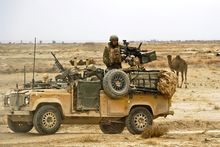
In their public statements U.S. officials had previously praised Pakistan's military effort against the militants during its offensive in South Waziristan in November 2009. Afghan President Hamid Karzai also started peace talks with Haqqani network groups in March 2010. and there were other peace initiatives including the Afghan Peace Jirga 2010. In July 2010, The Guardian newspaper reported that the campaign to "win hearts and minds" of Afghan civilians by U.S. troops has been proving more difficult than expected. One U.S. Army report read: "It seems to always be this way when we go there [to meet civilians]. No one wants anything to do with us." And a report on meeting up with school representatives mentioned students throwing rocks at soldiers and not welcoming their arrival, as has been reported on several occasions elsewhere. Pakistan's President Asif Ali Zardari said that Pakistan has lost over 35 billion U.S. dollars during the previous eight years as a result of the fight against militancy. According to the Afghan government, approximately 900 Taliban were killed in operations conducted during 2010. Due to increased use of IEDs by insurgents there was a significant increase in the number of injured coalition soldiers, mainly Americans, losing one limb or more or suffering major injury to their genital and pelvic areas. Beginning in May 2010 NATO special forces began to concentrate on surgical operations to capture or kill specific Taliban leaders which as of March 2011, according to the U.S. military, had resulted in the capture or killing of more than 900 low and mid-level Taliban commanders. Overall, 2010 saw the most insurgent attacks of any year since the war began, peaking in September at more than 1,500. Insurgent operations increased "dramatically" in two-thirds of Afghan provinces.
Troop surge
Deployment of additional U.S. troops continued in early 2010, with 9,000 of the planned 30,000 in place before the end of March and another 18,000 expected by June, with the 101st Airborne Division as the main effort. The Pentagon anticipated that U.S. troops in Afghanistan will outnumber those in Iraq for the first time since 2003.
The CIA, from a request by General McChrystal, the commander of NATO forces in Afghanistan, planned to increase teams of operatives, including their elite paramilitary officers from Special Activities Division (SAD), with U.S. military special operations forces. This combination worked well in Iraq and is largely credited with the success of that surge. The CIA also increased its campaign using Hellfire missile strikes on Al-Qaeda in Pakistan. The number of strikes in 2010, 115, more than doubled the 50 drone attacks that occurred in 2009.
The surge in troops also meant a sixfold increase in Special Forces operations. There were 700 air strikes in September 2010, alone versus 257 in all of 2009. From July 2010 to October 2010, 300 Taliban commanders and 800 foot soldiers were killed. Hundreds more insurgent leaders were killed or captured as 2010 came to a close. General David Petraeus characterized the damage Special Forces were inflicting on the insurgents this way: "We’ve got our teeth in the enemy’s jugular now, and we’re not going to let go."
The CIA created what would be called Counter-terrorism Pursuit Teams (CTPT) at the beginning of the war. This force grew to over 3,000 soldiers by 2010 and is considered one of the "best Afghan fighting forces". According to Woodward book Obama's War, Firebase Lilley as one of the nerve centers for the covert war conducted by the CIA's SAD. These units have not only been highly effective in operations against the Taliban and al-Qaeda forces in Afghanistan, but have expanded their operations into Pakistan. They were also important factors in both the "counterterrorism plus" and the full "counter-insurgency" options discussed by the Obama administration in the December 2010 review.
Wikileaks disclosure
On 25 July 2010, the release of 91,731 classified documents from the Wikileaks organization was made public. The documents cover U.S. military incident and intelligence reports from January 2004 to December 2009. Some of these documents included sanitised, and "covered up", accounts of civilian casualties caused by Coalition Forces. The reports also included many references to other incidents involving civilian casualties like the Kunduz airstrike and Nangar Khel incident. The leaked documents also contain reports of Pakistan collusion with the Taliban. According to Der Spiegel, "the documents clearly show that the Pakistani intelligence agency Inter-Services Intelligence (usually known as the ISI) is the most important accomplice the Taliban has outside of Afghanistan."
Pakistan and U.S. tensions
Tensions between Pakistan and the U.S. were heightened in late September after several Pakistan Frontier Corps soldiers were killed and wounded. The troops were attacked by a U.S. piloted aircraft that was pursuing Taliban forces near the Afghan-Pakistan border but for unknown reasons opened fire on two different Pakistan border posts. In retaliation for the strike, Pakistan closed the Torkham ground border crossing to NATO supply convoys for an unspecified period. This incident followed the recent release of a video allegedly showing uniformed Pakistan soldiers executing unarmed civilians. After the Torkham border closing, the Pakistani Taliban attacked the NATO convoys carrying supplies, killing several of the drivers and destroying around 100 tankers.
2011: U.S. and NATO drawdown
Battle of Kandahar
The Battle of Kandahar was part of an offensive named after the Battle of Bad'r that took place on 13 March 624, between Medina and Mecca. The Battle followed an announcement, 30 April 2011, that Taliban would launch their Spring offensive throughout the country.
On 7 May 2011, the Taliban launched a major offensive on Government buildings in Kandahar. Around 12:30 pm local time, the Taliban unleashed a major assault on government buildings throughout the city. The Taliban said their goal was to take control of Kandahar city. At least eight locations were attacked: the governor's compound, the mayor's office, the NDS headquarters, three police stations and two high schools. The battle continued onto a second day, 8 May 2011. The BBC's Bilal Sarwary called it "the worst attack in Kandahar province since the fall of the Taliban government in 2001, and a embarrassment for the Western-backed Afghan government."
Death of Osama bin Laden
On 2 May 2011, U.S. officials announced that al-Qaeda leader Osama bin Laden was killed in a Special Operation (code-named Operation Neptune Spear) to kill or capture Osama Bin Laden, conducted by the CIA and U.S. Navy SEALs, in Pakistan. Crowds gathered outside the White House in Washington, DC, chanting "USA, USA" after the news emerged, and President Barack Obama addressed the nation and the world from the East Room of the White House to tell the world of the operation.
Withdrawal
On 22 June, President Obama addressed the nation from the White House and announced that 10,000 troops would be withdrawn by the end of 2011 and an additional 23,000 troops will leave the country by the summer of 2012. After the withdrawal of 10,000 U.S. troops, only 80,000 left are participating in the war. In July 2011 Canada withdrew all of its combat troops, and has transitioned to a training role.
Following suit, other NATO countries announced reductions in troop numbers. The United Kingdom has stated that it will gradually start withdrawing some of its troops, however it has not yet specified numbers or dates. France has announced that it would withdraw roughly 1,000 soldiers by the end of 2012, with 3,000 soldiers remaining in Afghanistan at that point. Several hundreds would gradually come back at the end of 2011 and in the beginning of 2012, when the Afghan National Army takes control of the Surobi district. The remaining troops will continue to operate in Kapisa, and their complete withdrawal is expected by the end of 2014 or earlier if the security in this district is considered good enough.
Belgium announced they would withdraw half of their force starting January 2012. Norway announced it had started a withdrawal of its near 500 troops, and would be completely out of Afghanistan by 2014. Equally, the Spanish Prime Minister has announced the withdrawal of troops beginning in 2012 with a target of up to 40 percent of the current force withdrawing by the end of the first half of 2013, and complete withdrawal by 2014.
2011 U.S.-NATO attack in Pakistan
On the Peak of Tensions after "Operation Neptune Spear", an accidental, direct attack on Pakistan's armed forces by ISAF forces occurred on 26 November 2011, killing 24 Pakistani soldiers. Pakistan blocked NATO supply and ordered Americans to leave Shamsi Airfield. NATO Secretary General Anders Fogh Rasmussen said the attack was ‘tragic’ and ‘unintended’. "This (regret) is not good enough. We strongly condemn the attacks and reserve the right to take action,” said DG ISPR Major General Athar Abbas, while speaking to the national and international media from abroad on Monday. “This could have serious consequences in the level and extent of our cooperation.
2012: Strategic Agreement
Taliban attacks continued at the same rate as they did in 2011, remaining around 28,000 Taliban "enemy initiated" attacks.
Reformation of the United Front (Northern Alliance)
| “ | If the Taliban are imposed on Afghanistan, there will be resistance. | ” |
In late 2011 the National Front of Afghanistan (NFA) was created by Ahmad Zia Massoud, Abdul Rashid Dostum and Haji Mohammad Mohaqiq in what many analysts have described as a reformation of the military wing of the United Front (Northern Alliance) to oppose a return of the Taliban to power. Meanwhile, much of the political wing has reunited under the National Coalition of Afghanistan led by Abdullah Abdullah becoming the main democratic opposition movement in the Afghan parliament. Former head of intelligence, Amrullah Saleh, has created a new movement, Basej-i Milli (Afghanistan Green Trend), with support among the youth mobilizing about 10,000 people in an anti-Taliban demonstration in the capital Kabul in May 2011.
In January 2012, the National Front of Afghanistan raised concerns about the possibility of a secretive and untransparent deal between the US, Pakistan and the Taliban during a widely publicized meeting in Berlin. U.S. Congressman Louie Gohmert wrote, "These leaders who fought with embedded Special Forces to initially defeat the Taliban represent over 60-percent of the Afghan people, yet are being entirely disregarded by the Obama and Karzai Administrations in negotiations." After the meeting with US congressmen in Berlin the National Front signed a joint declaration stating among other things:
"We firmly believe that any negotiation with the Taliban can only be acceptable, and therefore effective, if all parties to the conflict are involved in the process. The present form of discussions with the Taliban is flawed, as it excludes anti-Taliban Afghans. It must be recalled that the Taliban extremists and their Al-Qaeda supporters were defeated by Afghans resisting extremism with minimal human embedded support from the United States and International community. The present negotiations with the Taliban fail to take into account the risks, sacrifices and legitimate interests of the Afghans who ended the brutal oppression of all Afghans.—National Front Berlin Statement, January 2012
High-profile U.S. military incidents
Beginning in January 2012 incidents involving US troops occurred which were described by The Sydney Morning Herald as “a series of damaging incidents and disclosures involving American troops in Afghanistan [...].” These incidents created fractures in the partnership between Afghanistan and the NATO troops operating in the country, raised the question whether discipline within U.S. troops is breaking down, undermined "the image of foreign forces in a country where there is already deep resentment owing to civilian deaths and a perception among many Afghans that US troops lack respect for Afghan culture and people" and strained the relations between Afghanistan and the United States. Besides an incident involving US troops who posed with body parts of dead insurgents and an video apparently showing a US helicopter crew singing "Bye-bye Miss American Pie" before blasting a group of Afghan men with a Hellfire missile these “high-profile U.S. military incidents in Afghanistan” also included the 2012 Afghanistan Quran burning protests and the Panjwai shooting spree.
Enduring Strategic Partnership Agreement
On 2 May 2012, Afghan President Hamid Karzai and U.S. President Barack Obama signed a strategic partnership agreement between the two countries, after the US president had arrived in Kabul as part of unannounced trip to Afghanistan on the first anniversary of Osama bin Laden's death. The U.S.-Afghanistan Strategic Partnership Agreement, officially entitled the "Enduring Strategic Partnership Agreement between the Islamic Republic of Afghanistan and the United States of America", provides the long-term framework for the relationship between Afghanistan and the U.S. after the drawdown of U.S. forces in the Afghanistan war. The Strategic Partnership Agreement went into effect on 4 July 2012 according to an announcement by US Secretary of State Hillary Clinton on 8 July 2012 at the Tokyo Conference on Afghanistan. On 7 July 2012, as part of the Enduring Strategic Partnership Agreement, the U.S. designated Afghanistan a major non-NATO ally after U.S. Secretary of State Hillary Clinton arrived to Kabul to meet with President Karzai. On 11 November 2012, as part of the Enduring Strategic Partnership Agreement, the U.S. and Afghanistan launched negotiations for a bilateral security agreement.
NATO Chicago Summit: Troops withdrawal and longterm presence
On 21 May 2012 the leaders of the NATO-member countries endorsed an exit strategy during the 2012 NATO Summit in Chicago. The NATO-led ISAF Forces will hand over command of all combat missions to Afghan forces by the middle of 2013, while shifting at the same time from combat to a support role of advising, training and assisting the Afghan security forces and then withdraw most of the 130,000 foreign troops by the end of December 2014. A new and different NATO mission will then advise, train and assist the Afghan security forces including the Afghan Special Operations Forces.
2013: Withdrawal
2013-01-11 Karzai-Obama-Meeting
In a visit to the United States by Afghan President Hamid Karzai in January 2012 the United States stated it's open to withdraw all of its troops til the end of 2014. U.S. Deputy national security adviser Benjamin J. Rhodes said that leaving no troops “would be an option that we would consider,” adding that “the president does not view these negotiations as having a goal of keeping U.S. troops in Afghanistan.” On January 11, 2012 Afghan President Karzai and U.S. President Obama agreed to accelerate the handover of combat operations from NATO to Afghan forces by spring 2013 rather than summer 2013, meaning Afghan forces will take the lead in combat operations. NATO troops will focus on training, advising and assisting their Afghan counterparts, but also fighting alongside them, when needed. "What's going to happen this spring is that Afghans will be in the lead throughout the country. That doesn't mean that coalition forces including U.S. forces are no longer fighting," Obama said. "They will still be fighting alongside Afghan troops. It does mean though that Afghans will have taken the lead and our presence, the nature of our work will be different. We will be in a training, assisting, advising role." “We achieved our central goal, or have come very close to achieving our central goal, which is to de-capacitate al-Qaeda, to dismantle them, to make sure that they can’t attack us again,” Obama added. “At the end of this conflict, we are going to be able to say that the sacrifices that were made by those men and women in uniform has brought about the goal that we sought.”
Obama also stated that he will determine the pace of U.S. combat troops drawdown and their withdrawal from Afghanistan by the end of 2014 after consultations with commanders on the ground. He also said any U.S. mission in Afghanistan beyond 2014 would focus solely on counterterrorism operations and training Afghan security forces. According to Obama any agreement on troop withdrawals must include an immunity agreement in which US troops are not subjected to Afghan law. "I can go to the Afghan people and argue for immunity for U.S. troops in Afghanistan in a way that Afghan sovereignty will not be compromised, in a way that Afghan law will not be compromised," Karzai replied.
Both leaders also agreed that the United States would hand over full control of Afghan prisoners and prisons to Afghanistan and to pull out American troops from Afghan villages in spring 2013. "The international forces, the American forces, will be no longer present in the villages, that it will be the task of the Afghan forces to provide for the Afghan people in security and protection," the Afghan president said.
Post 2014 presence plans for NATO and the United States
NATO and the United States are as of November/December 2012 planning their precise configuration of their post 2014 presence. For details regarding this presence and its planning process please see Withdrawal of U.S. troops from Afghanistan.
War Crimes
Throughout the War in Afghanistan war crimes have been committed by both sides in the conflict. These crimes have included massacres of civilians, bombings of civilian targets, terrorism, use of torture and the murder of prisoners of war. Additional common crimes include theft, arson, and the destruction of property.
Taliban War Crimes
In 2011 the New York Times reported that the Taliban was responsible for 3/4 of all civilian deaths in the War in Afghanistan. In 2013 the UN stated that the Taliban had been placing bombs along transit routes which is a war crime.
The Taliban has claimed responsibility for attacks on various civilian targets such as markets, aid workers, hotels and schools.
Northern Alliance War Crimes
In December 2001 the Dasht-i-Leili massacre took place, where between 250 and 3,000 Taliban fighters who had surrendered, were shot and/or suffocated to death in metal truck containers whilst being transported by Northern Alliance forces. Reports also place U.S. ground troops at the scene of the massacre. The Irish documentary Afghan Massacre - the Convoy of Death investigated these allegations and claimed that mass graves of thousands of victims were found by United Nations investigators and that the Bush administration blocked investigations into the incident.
U.S. War Crimes
On June 21, 2003 David Passaro, a CIA contractor and U.S. Army Ranger, murdered Abdul Wali, a prisoner at a US base 10 miles south of Asadabad, in Kunar Province, Afghanistan. Passaro was found guilty of one count of felony assault with a dangerous weapon and three counts of misdemeanor assault. He was sentenced to serve 8 years and 4 months in prison.
In 2005, The New York Times obtained a 2,000-page United States Army report concerning the homicides of two unarmed civilian Afghan prisoners by U.S. armed forces in 2002 at the Bagram Theatre Internment Facility (also Bagram Collection Point or B.C.P.) in Bagram, Afghanistan. The prisoners, Habibullah and Dilawar, were chained to the ceiling and beaten, which caused their deaths. Military coroners ruled that both the prisoners' deaths were homicides. Autopsies revealed severe trauma to both prisoners' legs, describing the trauma as comparable to being run over by a bus. Seven soldiers were charged.
During the summer of 2010, the military charged five members of the platoon with murder of three Afghan civilians in Kandahar province and collecting their body parts as trophies in what came to be known as the Maywand District murders. In addition, seven soldiers were charged with crimes such as hashish use, impeding an investigation, and attacking the whistleblower Spc. Justin Stoner.
On Sunday, 11 March 2012, the Kandahar massacre occurred when sixteen civilians were killed and six wounded in the Panjwayi District of Kandahar Province, Afghanistan. Nine of the victims were children, and eleven of the dead were from the same family. United States Army Staff Sergeant Robert Bales was taken into custody and charged with 16 counts of premeditated murder. The American and International Security Assistance Force (ISAF) authorities apologized for the incident and promised a thorough and quick investigation.
Cost of war
The cost of the war reportedly was a major factor as U.S. officials considered drawing down troops in 2011. A March 2011 Congressional Research Service report notes the following about Operation Enduring Freedom (OEF) Afghanistan: 1) following the Afghanistan surge announcement in 2009, Defense Department spending on Afghanistan has increased 50%, going from $4.4 billion to $6.7 billion a month. During that time, troop strength has gone from 44,000 to 84,000, and it is expected to be at 102,000 for fiscal year 2011; 2) The total operational cost for Afghanistan from the beginning of the conflict in 2001 through 2006 only slightly exceeds the amount spent in 2010 alone – $93.8 billion. The projected total cost relating to Afghanistan from inception to the fiscal year 2011 is expected to be $468 billion. The estimate for the cost of deploying one U.S. soldier in Afghanistan is over US$1 million dollars a year. In a 2011 news story, the CSM reported, "The United States and other Western nations that have borne the brunt of the cost of the Afghan war have been conspicuously absent from the bidding process on Afghanistan’s mineral deposits, leaving it to mostly to regional powers."
Risk of a failed state
In a 2008 interview, the then-head U.S. Central Command General David H. Petraeus, insisted that the Taliban were gaining strength. He cited the recent uptick in attacks in Afghanistan and in neighboring Pakistan. Petraeus also insisted that the challenges faced in Afghanistan are more complicated than the ones that were faced in Iraq during his tour and to turn around the recent events this would require removing militant sanctuaries and strongholds, which are widespread inside Afghanistan. Observers also have argued that the mission in Afghanistan is hampered by a lack of agreement on objectives, a lack of resources, lack of coordination, too much focus on the central government at the expense of local and provincial governments, and too much focus on Afghanistan instead of the region.
In November 2009, Afghanistan slipped three places in Transparency International's annual index of corruption perceptions, becoming the world's second most-corrupt country ahead of just Somalia. In the same month, Malalai Joya, a former member of the Afghan Parliament and the author of "Raising My Voice," expressed opposition to an expansion of the U.S. military presence in Afghanistan and concern about the future of her country. “Eight years ago, the U.S. and NATO – under the banner of women’s rights, human rights, and democracy – occupied my country and pushed us from the frying pan into the fire. Eight years is enough to know better about the corrupt, mafia system of President Hamid Karzai. My people are crushed between two powerful enemies. From the sky, occupation forces bomb and kill civilians ... and on the ground, the Taliban and warlords continue their crimes. It is better that they leave my country; my people are that fed up. Occupation will never bring liberation, and it is impossible to bring democracy by war.”
Pakistan is playing a central role in Afghanistan. A 2010 report published by the London School of Economics says that Pakistan's ISI has an "official policy" of support to the Taliban. The ISI provides funding and training to the Taliban. "Pakistan appears to be playing a double-game of astonishing magnitude," the report states. Amrullah Saleh, former director of Afghanistan's intelligence service, criticised: "We talk about all these proxies [Taliban, Haqqanis] but not the master of proxies, which is the Pakistan army. The question is what does Pakistan’s army want to achieve ...? They want to gain influence in the region" About the presence of foreign troops in Afghanistan he stated: "[T]hey fight for the U.S. national interest but ... without them we will face massacre and disaster and God knows what type of a future Afghanistan will have." ( see video)
Capacity of Afghan security forces
The plan to transfer security responsibility to Afghan forces is the centerpiece of U.S. President Barack Obama's revised Afghanistan strategy. U.S. policy called for boosting the Afghan National Army to 134,000 soldiers by October 2010. By May 2010 the Afghan Army had accomplished this interim goal and was on track to reach its ultimate number of 171,000 by 2011. This increase in Afghan troops was intended to allow the U.S. to begin withdrawing American forces in July 2011. The transfer of security responsibilities could not happen unless the Afghan government and the coalition could recruit, train and retain soldiers.
At the time, the Afghan National Army had severely limited fighting capacity. Even the best Afghan units lacked training, discipline and adequate reinforcements. In one new unit in Baghlan Province, soldiers had been found cowering in ditches rather than fighting. Some were suspected of collaborating with the Taliban against the Americans. "They don’t have the basics, so they lay down," said Capt. Michael Bell, who was one of a team of U.S. and Hungarian mentors tasked with training Afghan soldiers. "I ran around for an hour trying to get them to shoot, getting fired on. I couldn’t get them to shoot their weapons." In addition, 9 out of 10 soldiers in the Afghan National Army could not read.
The Afghan Army was plagued by inefficiency and endemic corruption. U.S. training efforts were drastically slowed by the corruption, widespread illiteracy, vanishing supplies, and lack of discipline. U.S. trainers reported missing vehicles, weapons and other military equipment, and outright theft of fuel provided by the U.S. Death threats were leveled against U.S. officers who tried to stop Afghan soldiers from stealing. Afghan soldiers often found improvised explosive devices and snipped the command wires instead of marking them and waiting for U.S. forces to come to detonate them. The Americans said this just allows the insurgents to return and reconnect them. U.S. trainers frequently removed the cell phones of Afghan soldiers hours before a mission for fear that the operation would be compromised. American trainers often spent large amounts of time verifying that Afghan rosters were accurate – that they are not padded with "ghosts" being "paid" by Afghan commanders who quietly collected the bogus wages.
Desertion has been a significant problem in the Afghan Army. One in every four combat soldiers quit the Afghan Army during the 12-month period ending in September 2009, according to data from the U.S. Defense Department and the Inspector General for Reconstruction in Afghanistan.
The Afghan National Police provides support to the Afghan army. Police officers in Afghanistan are largely illiterate. Approximately 17 percent of them test positive for illegal drugs. They are widely accused of demanding bribes. Attempts to build a credible Afghan police force were faltering badly, according to NATO officials, even as they acknowledge that the force would be a crucial piece of the effort to have Afghans manage their own security so American forces could begin leaving. Taliban infiltration is a constant worry; incompetence an even bigger one. A quarter of the officers quit every year, making the Afghan government’s goals of substantially building up the police force even harder to achieve.
Insider attacks
Beginning in 2011, insurgent forces in Afghanistan began using a tactic of insider attacks on ISAF and Afghan military forces. In the attacks, Taliban personnel or sympathizers belonging to, or pretending to belong to, the Afghan military or police forces would suddenly attack ISAF personnel, often within the security of ISAF military bases and Afghan government facilities. In 2011, for example, 21 insider attacks killed 35 coalition personnel. Forty-six insider attacks killed 63 and wounded 85 coalition troops, mostly American, in the first 11 months of 2012.
International reactions
Public opinion in 2001
When the invasion began in October 2001, polls indicated that about 88% of Americans and about 65% of Britons backed military action in Afghanistan.
A large-scale 37-nation poll of world opinion carried out by Gallup International in late September 2001 found that large majorities in most countries favored a legal response, in the form of extradition and trial, over a military response to 9/11: Only in three countries out of the 37 surveyed – the U.S., Israel, and India – did majorities favour military action in Afghanistan. In the other 34 countries surveyed, the poll found many clear majorities that favored extradition and trial instead of military action: in the United Kingdom (75%), France (67%), Switzerland (87%), Czech Republic (64%), Lithuania (83%), Panama (80%), Mexico (94%), and other countries.
An Ipsos-Reid poll conducted between November and December 2001 showed that majorities in Canada (66%), France (60%), Germany (60%), Italy (58%), and the U.K. (65%) approved of U.S. airstrikes while majorities in Argentina (77%), China (52%), South Korea (50%), Spain (52%), and Turkey (70%) opposed them.
Development of public opinion
In a 47-nation June 2007 survey of global public opinion, the Pew Global Attitudes Project found international opposition to the war. Out of the 47 countries surveyed, 4 had a majority that favoured keeping foreign troops: the U.S. (50%), Israel (59%), Ghana (50%), and Kenya (60%). In 41 of the 47 countries, pluralities want U.S. and NATO troops out of Afghanistan as soon as possible. In 32 out of 47 countries, clear majorities wanted this war over as soon as possible. Majorities in 7 out of 12 NATO member countries say troops should be withdrawn as soon as possible.
A 24-nation Pew Global Attitudes survey in June 2008 similarly found that majorities or pluralities in 21 of 24 countries want the U.S. and NATO to remove their troops from Afghanistan as soon as possible. Only in three out of the 24 countries – the U.S. (50%), Australia (60%), and Britain (48%) – did public opinion lean more toward keeping troops there until the situation has stabilized.
Since that June 2008 global survey, however, public opinion in Australia and Britain has also diverged from that in the U.S., and a majority of Australians and Britons now want their troops to be brought home from Afghanistan. A September 2008 poll found that 56% of Australians opposed the continuation of their country's military involvement in Afghanistan, while 42% support it. A November 2008 poll found that 68% of Britons want their troops withdrawn within the next 12 months. On the contrary, in the U.S., a September 2008 Pew survey found that 61% of Americans wanted U.S. troops to stay until the situation has stabilized, while 33% wanted them removed as soon as possible.
In a November 2009 Gallup poll, a record 66% of Americans said things were going badly for the U.S. in Afghanistan, up from 61% in early September. However, while public opinion was divided over Afghan troop requests, a majority of Americans continued to see a rationale for the use of military force in Afghanistan. A slight plurality of Americans favored troop increases, with 42%–47% favoringat least some troop increases to satisfy the military's requests, 39%–44% wanting reduction, and 7–9% wanting no changes in troop levels. Just 29% of Democrats favour any troop increases while 57% want to begin reducing troops. 36% of Americans approved of Obama's handling of Afghanistan, including 19% of Republicans, 31% of independents, and 54% of Democrats.
In a December 2009 Pew Research Centre poll, only 32 percent of Americans favored increasing U.S. troops in Afghanistan, while 40 percent favored decreasing them. Almost half of Americans, 49 percent, believed that the U.S. should "mind its own business" internationally and let other countries get along the best they can. That figure was an increase from 30 percent who said that in December 2002.
In an April 2011 Pew Research Center poll, there was little change in the American public's views about Afghanistan, with about 50% saying that the U.S. military effort was going very well or fairly well and only 44% supporting NATO troop presence in Afghanistan. The new survey shows little change since then – 50% favor removing U.S. and NATO troops as soon as possible while 44% favour maintaining the troops in Afghanistan until the situation is stabilized.
Afghan opinions
Recent polls of Afghans have found strong opposition to the Taliban and significant support of the American military presence. However the idea of permanent U.S. military bases vexes many people in Afghanistan.
According to a May 2009 BBC poll, 69% of Afghans surveyed thought it was at least mostly good that the U.S. military came in to remove the Taliban – a decrease from 87% of Afghans surveyed in 2005. 24% thought it was mostly or very bad – up from 9% in 2005. The poll indicated that 63% of Afghans were at least somewhat supportive of a U.S. military presence in the country – down from 78% in 2005. Just 18% supported increasing the U.S. military's presence, while 44% favored reducing it. 90% of Afghans surveyed opposed the presence of Taliban fighters, including 70% who were strongly opposed. By an 82%–4% margin, people said they preferred the current government to Taliban rule.
In a June 2009 Gallup survey, about half of Afghan respondents felt that additional U.S. forces would help stabilize the security situation in the southern provinces. But opinions varied widely across Afghanistan at the time; residents in the troubled South were mostly mixed or uncertain, while those in the West largely disagreed that more U.S. troops would help the situation.
In December 2009, many Afghan tribal heads and local leaders from the Pashtun south and east – the heartland of the Taliban insurgency – called for U.S. troop withdrawals. "I don't think we will be able to solve our problems with military force," said Muhammad Qasim, a tribal elder from the southern province of Kandahar. "We can solve them by providing jobs and development and by using local leaders to negotiate with the Taliban." "If new troops come and are stationed in civilian areas, when they draw Taliban attacks civilians will end up being killed," said Gulbadshah Majidi, a lawmaker and close associate of Mr. Karzai. "This will only increase the distance between Afghans and their government."
In late January 2010, Afghan protesters took to the streets for three straight days and blocked traffic on a highway that links Kabul and Kandahar. The Afghans were demonstrating in response to the deaths of four men in a NATO-Afghan raid in the village of Ghazni. Ghazni residents insisted that the dead were civilians.
Protests, demonstrations and rallies
The war has repeatedly been the subject of large protests around the world starting with the large-scale demonstrations in the days leading up to the official launch of Operation Enduring Freedom under George W. Bush in October 2001 and every year since. Many protesters consider the bombing and invasion of Afghanistan to be unjustified aggression. The deaths of Afghan civilians caused directly and indirectly by the U.S. and NATO bombing campaigns is also a major underlying focus of the protests. New organizations have arisen to oppose the war; for example, in January 2009, Brave New Foundation launched Rethink Afghanistan, a national campaign for non-violent solutions in Afghanistan built around a documentary film by director and political activist Robert Greenwald. Dozens of organizations planned (and eventually held) a national march for peace in Washington, D.C. on 20 March 2010.
Civilian casualties
There is no single official figure for the overall number of civilians killed by the war since 2001, but estimates for specific years or periods have been published by a number of organizations. According to a report by the United Nations, the Taliban were responsible for 76% of civilian casualties in Afghanistan in 2009. A UN report in June 2011 stated that 2,777 civilians were known to have been killed in 2010, with insurgents being responsible for 75% of the civilian casualties. Another United Nations report issued in July 2011 said "1,462 non-combatants died" in the first six months of 2011, with insurgents being responsible for 80% of the deaths. In 2011 a record 3,021 civilians were killed in the ongoing insurgency, the fifth successive annual rise. Very few people in Afghanistan have been unaffected by the armed conflict there. Those with direct personal experience make up 60% of the population, and most others also report suffering a range of serious hardships. In total, almost everyone (96%) has been affected in some way – either personally or due to the wider consequences of armed conflict. However, according to Nicholas Kristoff, improved healthcare resulting from the war has saved hundreds of thousands of lives.
Drug trade
From 1996-1999, the Taliban controlled 96% of Afghanistan's poppy fields and made opium its largest source of taxation. Taxes on opium exports became one of the mainstays of Taliban income and their war economy. According to Rashid, "drug money funded the weapons, ammunition and fuel for the war." In the New York Times, the Finance Minister of the United Front, Wahidullah Sabawoon, declared the Taliban had no annual budget but that they "appeared to spend US$ 300 million a year, nearly all of it on war." He added that the Taliban had come to increasingly rely on three sources of money: "poppy, the Pakistanis and bin Laden."
By 2000 Afghanistan accounted for an estimated 75% of the world's supply and in 2000 grew an estimated 3276 tonnes of opium from poppy cultivation on 82,171 hectares. At this juncture Omar passed a decree banning the cultivation of opium, and production dropped to an estimated 74 metric tonnes from poppy cultivation on 1,685 hectares. Many observers say the ban - which came in a bid for international recognition at the United Nations - was only issued in order to raise opium prices and increase profit from the sale of large existing stockpiles. The year 1999 had yielded a record crop and had been followed by a lower but still large 2000 harvest. The trafficking of accumulated stocks by the Taliban continued in 2000 and 2001. In 2002, the UN mentioned the "existence of significant stocks of opiated accumulated during previous years of bumper harvests." In September 2001 - before the 11 September attacks against the U.S. – the Taliban allegedly authorized Afghan peasants to sow opium again.
Soon after the 2001 U.S. led invasion of Afghanistan opium production increased markedly. By 2005, Afghanistan had regained its position as the world’s No. 1 opium producer and was producing 90% of the world’s opium, most of which is processed into heroin and sold in Europe and Russia. In 2009, the BBC reported that "UN findings say an opium market worth $65bn (£39bn) funds global terrorism, caters to 15 million addicts, and kills 100,000 people every year."
Human rights abuses
There have been multiple accounts of human rights violations in Afghanistan.
Taliban
According to a report by the United Nations, the Taliban were responsible for 76% of civilian casualties in Afghanistan in 2009. The Afghanistan Independent Human Rights Commission (AIGRC) called the Taliban's terrorism against the Afghan civilian population a war crime. According to Amnesty International, the Taliban commit war crimes by targeting civilians, including killing teachers, abducting aid workers and burning school buildings. Amnesty International said that up to 756 civilians were killed in 2006 by bombs, mostly on roads or carried by suicide attackers belonging to the Taliban. Some religious leaders haved condemned Taliban terrorist attacks and said these kinds of attacks are against Islamic ethics.
During the conflict, NATO has alleged that the Taliban have used civilians as human shields. As an example, NATO pointed to the victims of NATO air strikes in Farah province in May 2009, during which the Afghan government claims up to 150 civilians were killed. NATO stated that it had evidence that the Taliban forced civilians into buildings likely to be targeted by NATO aircraft involved in the battle. US Lieutenant Colonel Greg Julian, a spokesman for General McKiernan, NATO's Afghanistan commander, said of the Taliban's tactics, "This was a deliberate plan by the Taliban to create a civilian casualty crisis. These were not human shields; these were human sacrifices. We have intelligence that points to this." (NATO has not provided this intelligence to the public.) The increase in Taliban power has also led to increased human rights violations against women in Afghanistan, according to the U.S. State Department.
White phosphorus use
White phosphorus has been condemned by human rights organizations as cruel and inhumane because it causes severe burns. There are cases that have been confirmed of white phosphorus burns on the bodies of civilians wounded in Afghanistan caused by clashes between U.S. and Taliban forces near Bagram. The U.S. claims at least 44 instances in which militants have used white phosphorus in weapons or attacks. In May 2009, Colonel Gregory Julian, a spokesman for General McKiernan, the overall commander of U.S. and NATO forces in Afghanistan, confirmed that Western military forces in Afghanistan use white phosphorus to illuminate targets or as an incendiary to destroy bunkers and enemy equipment. US forces used white phosphorus to screen a retreat in the Battle of Ganjgal when regular smoke munitions were not available. The Afghan government later launched an investigation into the use of white phosphorus munitions.
